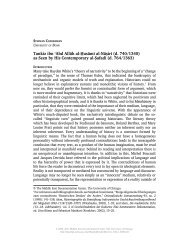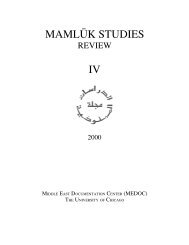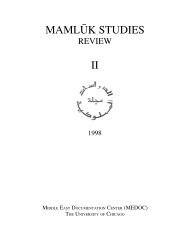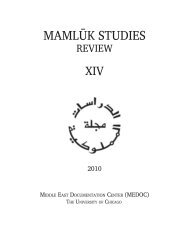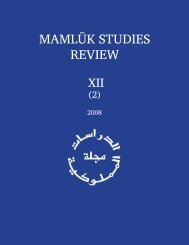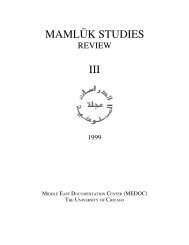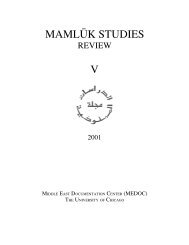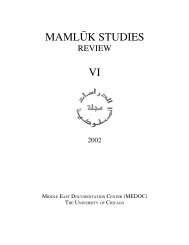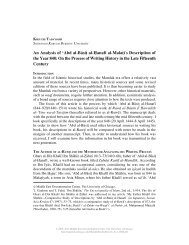Vol. VIII, no. 2 (2004) - Mamluk Studies Review - University of Chicago
Vol. VIII, no. 2 (2004) - Mamluk Studies Review - University of Chicago
Vol. VIII, no. 2 (2004) - Mamluk Studies Review - University of Chicago
You also want an ePaper? Increase the reach of your titles
YUMPU automatically turns print PDFs into web optimized ePapers that Google loves.
MAMLU±K STUDIES REVIEW VOL. 8, NO. 2, <strong>2004</strong> 7<br />
into the familiar Khaldu≠nian categories. In the beginning <strong>of</strong> the chapter al-Na≠bulus|<br />
writes:<br />
When I was given orders to survey the region <strong>of</strong> the Fayyum, I<br />
went from village to village and acquainted myself with its<br />
inhabitants. I would have even made a census, but for my fear that<br />
they would <strong>no</strong>tice [me doing so]. I have found the majority <strong>of</strong> the<br />
people to be Arab (aktharu ahliha≠ al-‘arab), divided into sections<br />
and tribes (al-afh˝a≠dh wa-al-shu‘u≠b). As for the h˝ad˝ar, there are<br />
very few <strong>of</strong> them, residing in <strong>no</strong> more than two or three villages.<br />
These few h˝ad˝ar communities are under the protection <strong>of</strong> the Arabs.<br />
In return, the Arabs take a fee from the revenue <strong>of</strong> their allotted<br />
portions (rizaqihim) 20 or hold rights to part <strong>of</strong> their lands, and the<br />
Arabs treat [the h˝ad˝ar] in a humiliating manner. The Arabs belong<br />
to three tribal confederacies (usű≠l), which are the Banu≠ Kila≠b,<br />
Banu≠ ‘Ajla≠n, and the al-Lawa≠th|y|n. I will <strong>no</strong>w list their dwelling<br />
places, excluding [the tribes] who seek pasture at the time <strong>of</strong> a<br />
drought and those who come there to transport the harvest. 21<br />
In this key chapter, al-Na≠bulus| informs us that almost the entire population <strong>of</strong> the<br />
Fayyum consisted <strong>of</strong> Arab tribesmen, which he also describes as badw, or bedouin.<br />
The only exceptions were a few h˝ad˝ar communities, who were under the domination<br />
<strong>of</strong> the Arab tribes. Al-Na≠bulus| goes on to list around one hundred villages—that<br />
is practically all the villages in the province—organized by their tribal affiliation.<br />
All these villages were populated by badw, with the exception <strong>of</strong> only three<br />
villages in which the population was h˝ad˝ar and the badw were only the guardsmen<br />
(khufara≠’). 22 The list corroborates al-Na≠bulus|'s general statement about the<br />
predominance <strong>of</strong> the badw, and shows that the population <strong>of</strong> the Fayyum was<br />
indeed dominated by three tribal groups. First in importance were the Banu≠ Kila≠b,<br />
then the Banu≠ ‘Ajla≠n, and then—much smaller—the Lawa≠thah, a Berber tribe.<br />
The Banu≠ Kila≠b dominated in the central, south, and west; the Banu≠ ‘Ajla≠n in the<br />
east and the <strong>no</strong>rth; while the Lawa≠thah dwelt in villages along the La≠hu≠n gap. 23<br />
20 On the meaning <strong>of</strong> rizqah in the <strong>Mamluk</strong> period, see N. Michel, "Les rizaq ih˝ba≠s|yah, terres<br />
agricoles en mainmorte dans l'Égypte mamelouke et ottomane: Étude sur les Dafa≠tir al-Ah˝ba≠s<br />
ottomans," Annales islamologiques 30 (1996): 105–98.<br />
21 Al-Na≠bulus|, Ta≠r|kh al-Fayyu≠m, 12–13.<br />
22 These were the village <strong>of</strong> Munsha’at Awla≠d ‘Arafah and the village <strong>of</strong> Ba≠jah, both guarded by<br />
the Banu≠ ‘A±m|r <strong>of</strong> the Banu≠ Kila≠b, and the village <strong>of</strong> Minyat al-Usquf (al-Na≠bulus|, Ta≠r|kh<br />
al-Fayyu≠m, 13, ll. 18–19).<br />
23 See summary in Keenan, "Fayyum Agriculture," 292.<br />
© <strong>2004</strong>, 2012 Middle East Documentation Center, The <strong>University</strong> <strong>of</strong> <strong>Chicago</strong>.<br />
http://mamluk.uchicago.edu/<strong>Mamluk</strong><strong>Studies</strong><strong>Review</strong>_<strong>VIII</strong>-2_<strong>2004</strong>.pdf



